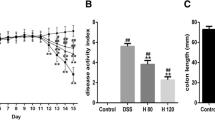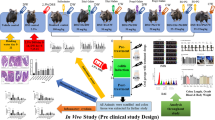Abstract
Previously, we reported that oral feeding of 1% green tea polyphenols (GTPs) aggravated the dextran sulfate sodium (DSS)-induced colitis in mice. In the present study, we assessed the toxicity of 1% GTPs in several organs from normal and DSS-exposed mice. Sixty-two male ICR mice were initially divided into four groups. Non-treated group (group 1, n = 15) was given standard diet and water, GTPs (group 2, n = 15) received 1% GTPs in diet and water, DSS (group 3, n = 15) received diet and 5% DSS in water, and GTPs + DSS group (group 4, n = 17) received 1% GTPs in diet and 5% DSS in water. We found that group 4 significantly increased (P < 0.05) kidney weight, the levels of serum creatinine and thiobarbituric acid-reactive substances in both kidney and liver, as compared with those in group 3. The mRNA expression levels of antioxidant enzymes and heat-shock proteins (HSPs) in group 4 were lower than those of group 3. For instance, heme oxygenase-1 (HO-1), HSP27, and 90 mRNA in the kidney of group 4 were dramatically down-regulated as compared with those of group 3. Furthermore, 1% GTPs diet decreased the expression of HO-1, NAD(P)H:quinone oxidoreductase 1 (NQO1) and HSP90 in kidney and liver of non-treated mice. Taken together, our results indicate that high-dose GTPs diet disrupts kidney functions through the reduction of antioxidant enzymes and heat-shock protein expressions in not only colitis but also non-treated ICR mice.






Similar content being viewed by others
References
Abboud PA, Hake PW, Burroughs TJ, Odoms K, O'Connor M, Mangeshkar P, Wong HR, Zingarelli B (2008) Therapeutic effect of epigallocatechin-3-gallate in a mouse model of colitis. Eur J Clin Pharmacol 579(1–3):411
Anwar A, Siegel D, Kepa JK, Ross D (2002) Interaction of the molecular chaperone Hsp70 with human NAD(P)H:quinone oxidoreductase 1. J Biol Chem 277(16):14060
Araki Y, Andoh A, Fujiyama Y (2003) The free radical scavenger edaravone suppresses experimental dextran sulfate sodium-induced colitis in rats. Int J Mol Med 12(1):125
Araki Y, Mukaisyo K, Sugihara H, Fujiyama Y, Httori T (2010) Increased apoptosis and decreased proliferation of colonic epithelium in dextran sulfate sodium-induced colitis in mice. Oncol Rep 24(4):869
Bhattacharrya S, Dudeja PK, Tobacman JK (2009) ROS, HSP27, and IKKbeta mediate dextran sodium sulfate (DSS) activation of Ikappaba, NFKappaB, and IL-8. Inflamm Bowel Dis 15(5):673
Cai EP, Lin JK (2009) Epigallocatechin gallate (EGCG) and rutin suppress the glucotoxicity through activating IRS2 and AMPK signaling in rat pancreatic beta cells. J Agric Food Chem 57(20):9817
Calabrese EJ, Baldwin LA (2002) Applications of hormesis in toxicology, risk assessment and chemotherapeutics. Trends Pharmacol Sci 23(7):331
Chung LY, Cheung TC, Kong SK, Fung KP, Choy YM, Chan ZY, Kwok TT (2001) Induction of apoptosis by green tea catechins in human prostate cancer DU145 cells. Life Sci 68(10):1207
Desbuards N, Hyvelin JM, Machet MC, Eder V, Garrigue MA, Halimi JM, Antier D (2009) Heme oxygenase-1 inducer hemin attenuates the progression of remnant kidney model. Nephron Exp Nephrol 113(1):e35
Furukawa A, Oikawa S, Murata M, Hiraku Y, Kawanishi S (2003) (−)-Epigallocatechin gallate causes oxidative damage to isolated and cellular DNA. Biochem Pharmacol 66(9):1769
Guo Q, Zhao B, Li M, Shen S, Xin W (1996) Studies on protective mechanisms of four components of green tea polyphenols against lipid peroxidation in synaptosomes. Biochim Biophys Acta 1304(3):210
Hackl C, Mori A, Moser C, Lang SA, Dayoub R, Weiss TS, Schlitt HJ, Geissler EK, Hellerbrand C, Stoeltzing O (2010) Effect of heat-shock protein-90 (HSP90) inhibition on human hepatocytes and on liver regeneration in experimental models. Surgery 147(5):704
Hosakawa Y, Hosakawa I, Ozaki K, Nakanishi T, Nakane H, Matsuo T (2010) Tea polyphenols inhibit IL-6 production in tumor necrosis factor superfamily 14-stimulated human gingival fibroblasts. Mol Nutr Food Res 54(2):S151
Hu S, Ciancio MJ, Lahav M, Fujiya M, Lichtenstein L, Anant S, Musch MW, Chang EB (2007) Translation inhibition of colonic epithelial heat shock proteins by IFN-gamma and TNF-alpha in intestinal inflammation. Gastroenterology 133(6):1893
Isbrucker RA, Edwards JA, Wolz E, Davidovich A, Bausch J (2006) Safety studies on epigallocatechin gallate (EGCG) preparations. Part 2: dermal, acute and short-term toxicity studies. Food Chem Toxicol 44(5):636
Isemura M, Saeki K, Kimura T, Hayakawa S, Minami T, Sazuka M (2000) Tea catechins and related polyphenols as anti-cancer agents. Biofactors 13(1–4):81
Kankuri E, Hämäläinen M, Hukkanen M, Salmenperä P, Kivilaakso E, Vapaatalo H, Moilanen E (2003) Suppression of pro-inflammatory cytokine release by selective inhibition of inducible nitric oxide synthase in mucosal explants from patients with ulcerative colitis. Scand J Gastroenterol 38(2):186
Keshavarzian A, Sedghi S, Kanofsky J, List T, Robinson C, Ibrahim C, Winship D (1992) Excessive production of reactive oxygen metabolites by inflamed colon: analysis by chemiluminescence probe. Gastroenterology 103(1):177
Kim M, Murakami A, Ohigashi H (2007) Modifying effects of dietary factors on (−)-epigallate-induced pro-matrix metalloproteinase-7 production in HT-29 human colorectal cancer cells. Biosc Biotechnol Biochem 71(10):2442
Kim M, Murakami A, Miyamoto S, Tanaka T, Ohigashi H (2010) The modifying effects of green tea polyphenols on acute colitis and inflammation-association colon carcinogenesis in male ICR mice. Biofactors 36(1):43
Kitajima S, Takuma S, Morimoto M (1999a) Changes in colon mucosal permeability in mouse colitis induced dextran sulfate sodium. Exp Anim 48(3):137
Kitajima S, Takuma S, Morimoto M (1999b) Tissue distribution of dextran sulfate sodium (DSS) in the acute phase of murine DSS-induced colitis. J Vet Med Sci 61(1):67
Köken T, Serteser M, Kahraman A, Akbulut G, Dilek ON (2004) Which is more effective in the prevention of renal ischemia-reperfusion-induced oxidative injury in the early period in mice: interleukin (IL)-10 or anti-IL-12? Clin Biochem 37(1):50
Kweon MH, Adhami VM, Lee JS, Mukhtar H (2006) Constitutive overexpression of Nrf2-dependent heme oxygenase-1 in A549 cells contributes to resistance to apoptosis induced by epigallocatechin 3-gallate. J Biol Chem 281(44):33761
Kwon KH, Murakami A, Hayashi R, Ohigashi H (2005) Interleukin-1 beta targets interleukin-6 in progressing dextran sulfate sodium-induced experimental colitis. Biochem Biophys Res Commun 337(2):647
Lambert JD, Kennett MJ, Sang S, Reuhl KR, Ju J, Yang CS (2010) Yang, C., Hepatotoxicity of high oral dose (−)-epigallocatechin-3-gallate in mice. Food Chem Toxicol 48(1):409
Li C, Li C, Meng X, Winnik B, Lee MJ, Lu H, Sheng S, Buckley B, Yang CS (2001) Analysis of urinary metabolites of tea catechins by liquid chromatography/electrospray ionization mass spectrometry. Chem Res Toxicol 14(6):702
Li Y, Zhang T, Jiang Y, Lee HF, Schwartz SJ, Sun D (2009) (−)-Epigallocatechin-3-gallate inhibits Hsp90 function by impairing Hsp90 association with cochaperones in pancreatic cancer cell line Mia Paca-2. Mol Pharm 6(4):1152
Li GX, Chen YK, Hou Z, Xiao H, Jin H, Lu G, Lee MJ, Liu B, Guan F, Yang Z, Yang CS (2010) Pro-oxidative activities and dose-response relationship of (−)-epigallocatechin-3-gallate in the inhibition of lung cancer growth: a comparative study in vivo and in vitro. Carcinogenesis 31(5):902
Mazzanti G, Menniti-Ippolito F, Moro PA, Cassetti F, Raschetti R, Santuccio C, Mastrangelo S (2009) Hepatotoxicity from green tea: a review of the literature and two unpublished cases. Eur J Clin Pharmacol 65(4):331
Mochizuki M, Hasegawa N (2010) (−)-epigallocatechin 3-gallate reduces experimental colon injury in rats by regulating macrophage and mast cell. Phytother Res 24(S1):S120
Mori T, Ishii T, Akagawa M, Nakamura Y, Nakayama T (2010) Covalent binding of tea catechins to protein thiols: the relationship between stability and electrophilic reactivity. Biosc Biotechnol Biochem 74(12):2451
Musch MW, Ciancio MJ, Sarge K, Chang EB (1996) Induction of heat shock protein 70 protects intestinal epithelial IEC-18 cells from oxidant and thermal injury. Am J Physiol 270(2 Pt 1):C429
Na HK, Kim EH, Jung JH, Lee HH, Hyun JW, Surh YJ (2008) (−)-Epigallocatechin gallate induces Nrf2-mediated antioxidant enzyme expression via activation of PI3K and ERK in human mammary epithelial cells. Arch Biochem Biophys 476(2):171
Nakagawa T, Yokozawa T, Sano M, Takeuchi S, Kim M, Minamoto S (2004) Activity of (−)-epigallocatechin 3-O- gallate against oxidative stress in rats with adenine-induced renal failure. J Agric Food Chem 52(7):2103
Ogborne RM, Rushworth SA, O'Connell MA (2008) Epigallocatechin activates haem oxygenase-1 expression via protein kinase Cδ and Nrf2. Biochem Biophys Res Commun 373(4):584
Ohkawara T, Nishihira J, Takeda H, Miyashita K, Kato K, Kato M, Sugiyama T, Asaka M (2005) Geranylgeranylacetone protects mice from dextran sulfate sodium-induced colitis. Scand J Gastroenterol 40(9):1049
Okayasu I, Hatakeyama S, Yamada M, Ohkusa T, Inagaki Y, Nakaya R (1990) A novel method in the induction of reliable experimental acute and chronic ulcerative colitis in mice. Gastroenterology 98(3):694
Okushio K, Suzuki M, Matsumoto N, Nanjo F, Hara Y (1999) Methylation of tea catechins by rat liver homogenates. Biosc Biotechnol Biochem 63(2):430
Osburn WO, Wakabayashi N, Misra V, Nilles T, Biswal S, Trush MA, Kensler TW (2006) Nrf2 regulates an adaptive response protecting against oxidative damage following diquat-mediated formation of superoxide anion. Arch Biochem Biophys 454(1):7
Paquay JB, Haenen GR, Stender G, Wiseman SA, Tijburg LB, Bast A (2000) Protection against nitric oxide toxicity by tea. J Agric Food Chem 48(11):5768
Paul G, Battaille F, Obermeier F, Bock J, Klebl F, Strauch U, Lochbaum D, Rümmele P, Farkas S, Schölmerich J, Fleck M, Rogler G, Herfarth H (2005) Analysis of intestinal haem oxygenase-1 (HO-1) in clinical and experimental colitis. Clin Exp Immunol 140(3):547
Rezai-Zadeh K, Aredash GW, Hou H, Fernandez F, Jensen M, Runfeldt M, Shytle RD, Tan J (2008) Green tea epigallocatechin-3-gallate (EGCG) reduces beta-amyloid mediated cognitive impairment and modulates tau pathology in Alzheimer transgenic mice. Brain Res 1214(12):177
Sahin K, Tuzuc M, Gencoglu H, Dogukan A, Timurkan M, Sahin N, Aslan A, Kucuk O (2010) Epigallocatechin-3-gallate activates Nrf2/HO-1 signaling pathway in cisplatin-induced nephrotoxicity in rats. Life Sci 87(7–8):240
Sang S, Lambert JD, Hong J, Tian S, Lee MJ, Stark RE, Ho CT, Yang CS (2005) Synthesis and structure identification of thiol conjugates of (−)-epigallocatechin gallate and their urinary levels in mice. Chem Res Toxicol 18(11):1762
Shi Q, Domg Z, Wei H (2007) The involvement of heat shock proteins in murine liver regeneration. Cell Mol Immunol 4(1):53
Suganuma M, Okabe S, Oniyama M, Tada Y, Ito H, Fujiki H (1998) Wide distribution of [3H] (−)-epigallocatechin gallate, a cancer preventive tea polyphenol, in mouse tissue. Carcinogenesis 19(10):1771
Tanaka K, Namba T, Arai Y, Fujimoto M, Adachi H, Sobue G, Takeuchi K, Nakai A, Mizushima T (2007) Genetic evidence for a protective role for heat shock factor 1 and heat shock protein 70 against colitis. J Biol Chem 282(32):23240
Tran PL, Kim SA, Choi HS, Yoon JH, Ahn SG (2010) Epigallocatechin-3-gallate suppresses the expression of HSP70 and HSP90 and exhibits anti-tumor activity in vitro and in vivo. BMC Cancer 10:276. doi:10.1186/1471-2407-10-276
Wang WP, Guo X, Koo MW, Wong BC, Lam SK, Ye YN, Cho CH (2001) Protective role of heme oxygenase-1 on trinitrobenzene sulfonic acid-induced colitis in rats. Am J Physiol Gastrointest Liver Physiol 281(2):G586
Wang JS, Luo H, Wang P, Tang L, Yu J, Huang T, Cox S, Gao W (2008) Validation of green tea polyphenol biomarkers in a phase II human intervention trial. Food Chem Toxicol 46(1):232
Wischmeyer PE, Musch MW, Madonna MB, Thisted R, Chang EB (1997) Glutamine protects intestinal epithelial cells: role of inducible HSP70. Am J Physiol Gastrointest Liver Physiol 272(4 Pt 1):G879
Xue H, Sufit AJ, Wischmeyer PE (2011) Glutamine therapy improves outcome of in vitro and in vivo experiment colitis models. JPEN J Parenter Enteral Nutr 35(2):188
Yamabe N, Yokozawa T, Oya T, Kim M (2006) Therapeutic potential of (−)-epigallocatechin 3-O- gallate on renal damage in diabetic nephropathy model rats. J Pharmacol Exp Ther 319(1):228
Acknowledgements
This work was supported by the Programme for Promotion of Basic and Applied Researches for Innovations in Bio-oriented Industry and by Research and Development Projects for Application in Promoting New Policy of Agriculture Forestry and Fisheries, Ministry of Agriculture, Forestry and Fisheries, Japan (Grant No. 23005).
Author information
Authors and Affiliations
Corresponding author
Rights and permissions
About this article
Cite this article
Inoue, H., Akiyama, S., Maeda-Yamamoto, M. et al. High-dose green tea polyphenols induce nephrotoxicity in dextran sulfate sodium-induced colitis mice by down-regulation of antioxidant enzymes and heat-shock protein expressions. Cell Stress and Chaperones 16, 653–662 (2011). https://doi.org/10.1007/s12192-011-0280-8
Received:
Revised:
Accepted:
Published:
Issue Date:
DOI: https://doi.org/10.1007/s12192-011-0280-8




